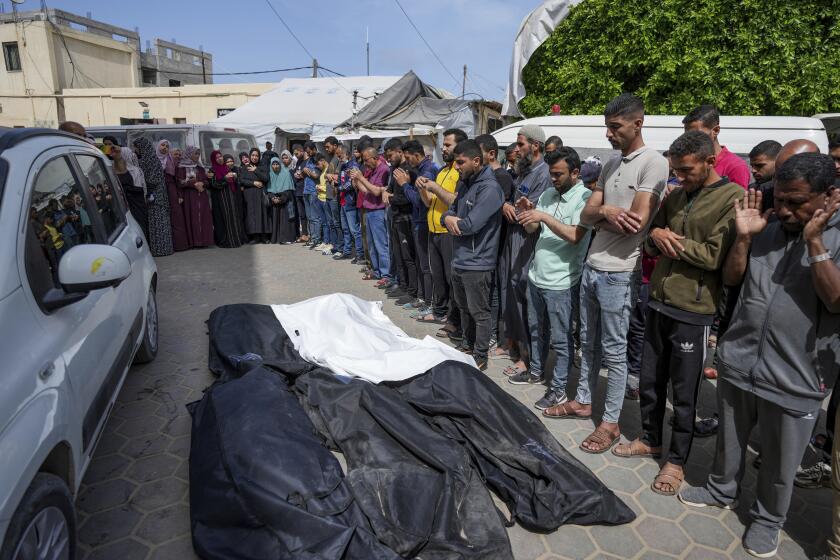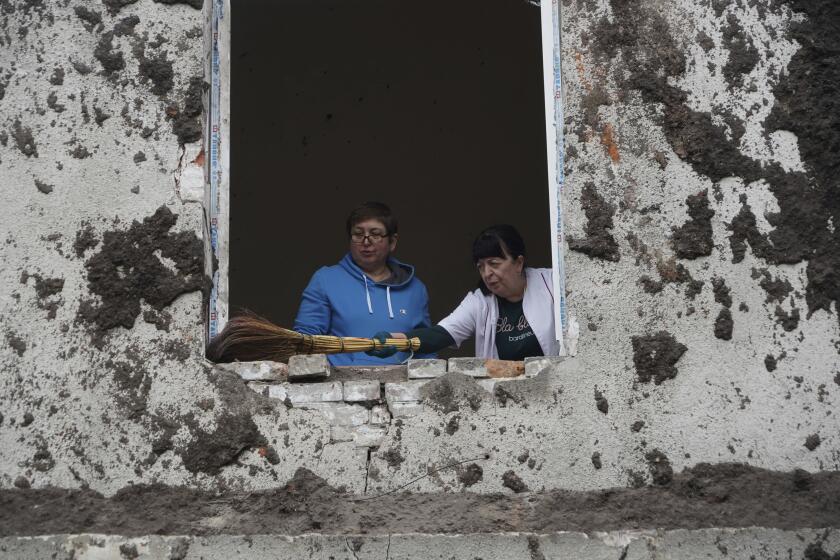Both Sides in Gaza Standoff Have Much to Lose
The tense weeklong standoff over Palestinian militants’ capture of an Israeli soldier has become laden with significance far beyond the fate of the missing 19-year-old tank gunner.
Whether or not the soldier is ultimately freed, events have been set in motion that could lead to a prolonged Israeli military entanglement in the Gaza Strip, a troubled terrain that the Jewish state thought it had relinquished for good.
In addition, analysts say the confrontation could imperil Israeli Prime Minister Ehud Olmert’s plans to cede most of the West Bank to the Palestinians to create a state, and perhaps result in the long-term strengthening of the Hamas movement -- whether or not the Islamist group survives as a governing power.
If Israel and the Palestinians can agree on one thing, it is that, by accident or by design, the stakes in this brewing battle have become extremely high. And each side is aware that it has much to lose and little to gain.
“There is no good outcome here,” said Raji Sourani, a human rights activist in Gaza. “Only bad ones and worse ones.”
For many on each side, the ongoing siege of Gaza is a death knell to hopes that by now, nearly a year after Israel’s landmark withdrawal of troops and Jewish settlers, the territory would be well on the way to becoming a prototype for Palestinian statehood -- with a viable economy, a measure of autonomy and functioning democratic institutions.
“It seems we have gone far, far backward, not forward at all,” said Gaza fisherman Mohammed Hamzi. Like others in Gaza’s small, ragged fishing fleet, he has ventured less than 30 yards offshore this week, afraid of being targeted by Israeli gunboats.
Although tensions between Israel and the Palestinians have been running high since Hamas took power three months ago, both sides have seemed almost taken aback by how quickly what could have been a commonplace border incident escalated into a major crisis.
Hit-and-run raids by Palestinian militants on remote Israeli military posts, such as the June 25 attack that resulted in the capture of Cpl. Gilad Shalit, were a regular fixture during Israel’s nearly four-decade occupation of Gaza. Even the tunneling method used by the militants had been employed many times before; the difference this time was that for the first time since the pullout, attackers successfully dug their way under the Gaza border fence.
The raid by three Hamas-allied militant factions left two Israeli soldiers and two assailants dead. But what might have then been a predictable and limited equation of strike and retaliation was vastly altered by the fact that the militants were able to spirit away a soldier -- a nightmare scenario for Israel, which has often spent years trying to ascertain the fate of soldiers seized by Arab guerrillas.
Through much of the country’s history, hostage crises -- Munich, Entebbe -- have served as defining moments, and the conclusion usually drawn by Israel is that it is better to strike decisively than to talk.
The Israeli military establishment reflexively fears any erosion of its power of deterrence, and for that reason, the early days of this offensive, which began Wednesday when troops and tanks moved into a slice of southern Gaza, were a source of frustration to army chiefs.
Every day brought reports in the Israeli media that the military brass was aghast at the spectacle of the crack Golani infantry brigade parked on Gaza’s northern border, firing artillery salvos but ordered to refrain from entering the coastal strip.
Indeed, days passing without an expected incursion in the north seemed to bolster the Palestinians’ sense of defiance. On Saturday, a screaming flyover of the Gaza coast by Israeli fighter jets, punctuated by earsplitting sonic booms, drew a round of derisive applause from Palestinian patrons at a seaside restaurant.
“Oh Israel, come to Gaza!” Hamas supporters chanted at a recent rally in Gaza City. “Come to Gaza and find your graves waiting!”
Senior Israeli security officials met Saturday night to plan the next phase of the operation, including an expected drive into Gaza’s north, as mediators’ efforts to free the soldier appeared to flag.
But the political implications of the standoff have threatened to overshadow the military offensive. Olmert’s government has declared that it draws no distinction between the elected Hamas government and the group’s military wing, which was one of the factions claiming responsibility for the soldier’s abduction.
To that end, Israel rounded up dozens of Hamas officials in the West Bank, bombed the Hamas-run Interior Ministry in Gaza and threatened to assassinate Hamas figures, including Palestinian Authority Prime Minister Ismail Haniyeh and exiled Hamas political leader Khaled Meshaal, who is based in Damascus, the Syrian capital.
Haniyeh has called the campaign nothing less than an attempted coup against an elected government, and appealed for international condemnation of Israel’s actions. In Gaza, the perceived effort by Israel to topple the Hamas government has mainly served to bolster loyalty to the Islamist group.
“Look, maybe we made a mistake electing them, but if we did, it would be our mistake to undo, in a democratic way,” said Hakim abu Samra, a civil servant from the northern Gaza Strip, echoing an opinion voiced by many.
“It’s not for anyone from the outside to decide,” said Abu Samra. “Not Israel, and not the United States. Shame on them. Shame.”
The jailed Hamas political leaders may also see their stock rise among ordinary Palestinians, because being imprisoned by Israel is considered a badge of honor. And Hamas officials have vowed to simply double up on ministerial duties and take directives from those Cabinet members who are behind bars.
“They’re still the government,” said Palestinian political scientist Ali Jarbawi.
Within Hamas, the confrontation has had the effect of drowning out the voices of the movement’s more pragmatic elements. Hamas and the rival Fatah movement have tentatively agreed on a political platform that would implicitly recognize Israel by recognizing previous accords and setting the goal of statehood on land seized by Israel in the 1967 Middle East War.
Although it does not meet international demands for Hamas to renounce violence and recognize the Jewish state, the proposed platform does represent a softening of the group’s hard-line stance. But because of the military confrontation, the document went almost unremarked upon.
For rival Palestinian factions, the confrontation has brought a certain relief at standing together against a common enemy: Israel. Over the last two months, gunmen from the ruling Hamas and the Fatah movement it defeated in elections had been locked in an escalating feud that left at least 20 people dead.
Once the Israeli tanks moved in, those quarrels were put aside.
Israel is aware that the longer the standoff continues, the more international pressure will mount over the humanitarian situation in Gaza. Tens of thousands of people are without electricity, fuel for generators is running dry, and hospitals say critically ill patients will soon begin dying because of drug shortages.
Ahmed Hamdan, who lives in Beit Hanoun, in northern Gaza, said his family was worried that there would be no electricity to power the respirator for his daughter, who has asthma. Israeli forces have dropped leaflets in the village telling residents they will be in danger if they remain in their homes.
But like many Gazans, Hamdan took a fatalistic view.
“If the tanks come, they come,” he said. “It is in the hands of God.”
More to Read
Start your day right
Sign up for Essential California for news, features and recommendations from the L.A. Times and beyond in your inbox six days a week.
You may occasionally receive promotional content from the Los Angeles Times.






